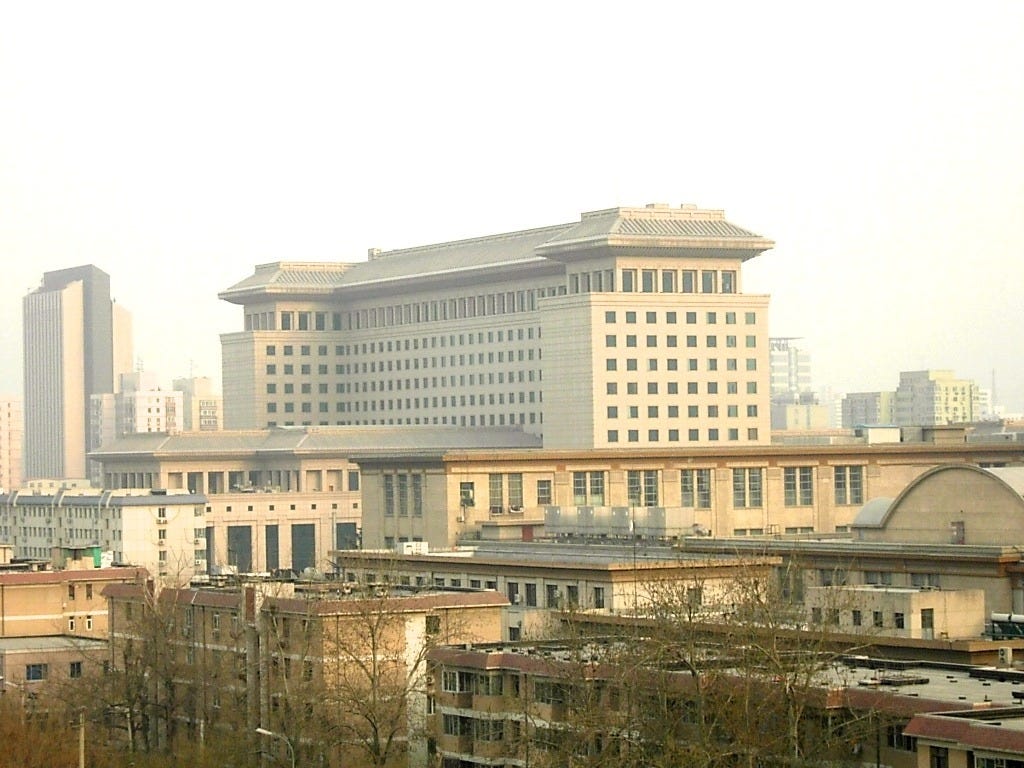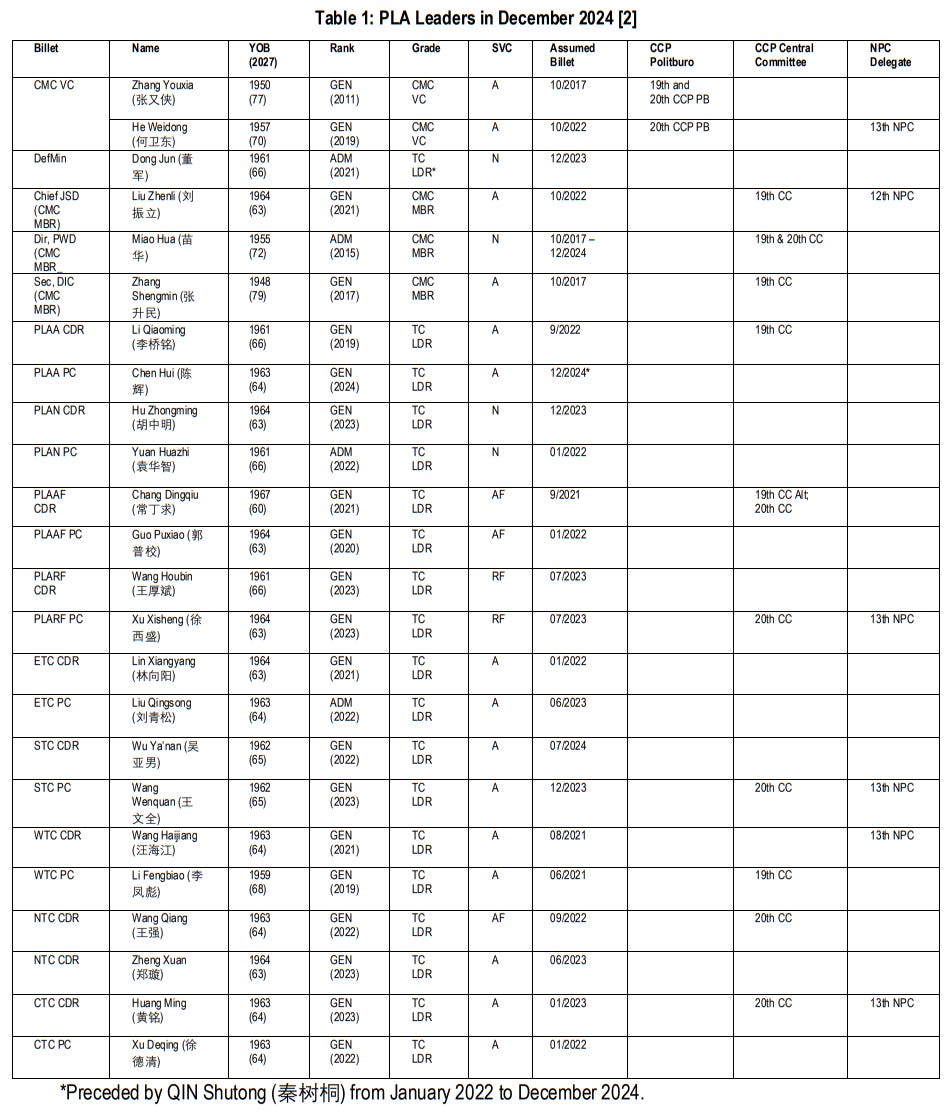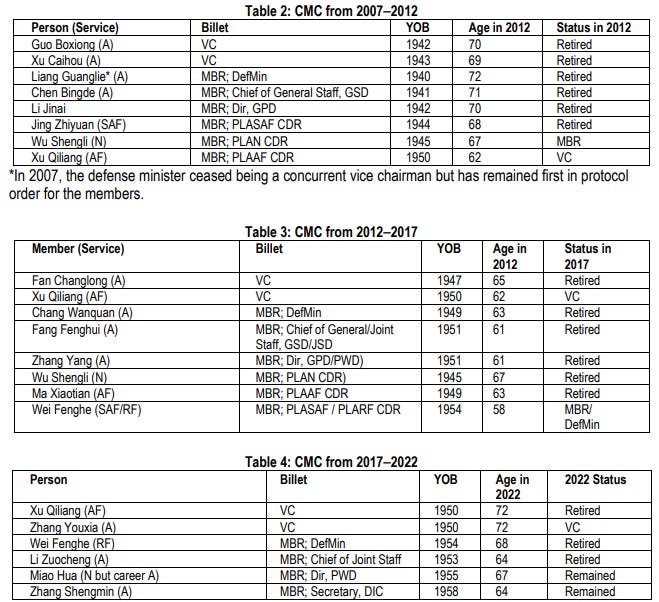
Executive Summary:
The size and scope of the Central Military Commission (CMC) has reduced dramatically since 2004, and the makeup of the military leadership is expected to change completely by the end of the decade. It is not clear what impact this turnover will have on the PLA’s ability to conduct war if needed.
Retirement norms indicate that only one of the two CMC vice chairmen will remain in position along with a new director of the CMC Political Work Department after the 21st Party Congress in 2027, while nine of the current 23 PLA leaders will change. The 11 other leaders will likely retire within one or two years of the congress.
The current CMC only has five people, due to the removal of director of the Political Work Department Miao Hua for corruption and the continued absence of the defense minister from the CMC.
Defense minister Dong Jun represents an apparent demotion for the defense ministry. His reduced ability to advocate for military affairs within the State Council and during national policy-setting could complicate the military-to-military relationship between the People’s Republic of China (PRC) and the United States.
This article identifies all the key People’s Liberation Army (PLA) leaders at the end of 2024. It also discusses recent changes to the makeup of that leadership, including those that have resulted from corruption investigations as well as surveying changes that are likely to take place by the 21st Chinese Communist Paty (CCP) National Congress, set to take place in late 2027. Retirement age norms have varied throughout the history of the People’s Republic of China (PRC) and there are always exceptions. Currently, it appears that the norm is that the central military commission (CMC) vice chairmen can remain on active duty until they are 70 years old but that all other senior leaders, including CMC members, service commanders, and theater command commanders must retire at age 65. However, there are always exceptions that allow them to remain in their billet after they have met their mandatory age requirement.
The senior leadership will look completely different than it is today by 2029 as a result. After 2027, only one of the two CMC vice chairmen will remain in position along with a new director of the CMC Political Work Department, while nine of the current leaders will retire at or before the 21st Party Congress and 11 other leaders, who will be 63 or 64 years old, will most likely retire within one or two years of the congress. Of note, each service and theater command have their own party congress, which normally takes place two years after the National Party Congress. However, leadership changes normally take place at the national congresses (CASI, April 12, 2021). The key billets that are addressed in this article include:
The two vice chairmen and three members of the CCP and state central military commissions (CMC), including the chief of the Joint Staff Department, the director of the Political Work Department, and the secretary of the Discipline Inspection Commission.
The commanders and political commissars for the four services—the PLA Army, Navy, Air Force, and Rocket Force.
The commanders and political commissars of the five theater commands—Eastern, Southern, Western, Northern, and Central.
It is not clear what the impact on the overall leadership changes will have on the PLA’s ability to conduct war if needed, but a better understanding of who the key decisionmakers are provides a starting point for assessing the PLA’s readiness.
Changing Makeup of the CMC Membership in the 21st Century
The membership of the Central Military Commission has changed substantially in the 21st Century and especially in the last decade following thoroughgoing organizational reforms that began in 2016 (China Brief, February 4, 2016; February 23, 2016; April 26, 2024). The major changes announced during party congresses, which have reduced the size and scope of the CMC dramatically since 2004, are shown in the bullets below (RAND, 2002; DGI, July 17, 2018): [1]
16th Party Congress (2002): Chairman Jiang Zemin, two vice chairmen, including the concurrent defense minister; four members (chief of the General Staff Department, director of the General Political Department, director of the General Logistics Department, and director of the General Armament Department.
2004: The commanders of the PLA Navy, Air Force, and Second Artillery Force were added as members.
17th Party Congress (2007): Chairman Hu Jintao, two vice chairmen, eight members (defense minister, chief of the General Staff Department, director of the General Political Department, director of the General Logistics Department, director of the General Armament Department, and commanders of the Navy, Air Force, and Second Artillery Force).
Xi Jinping was added as a civilian vice chairman in 2010.
18th Party Congress (2012): Chairman Xi Jinping (no civilian vice chairman since 2012), two vice chairmen, eight members (same billets as 2007).
19th Party Congress (2017): Chairman Xi Jinping, two vice chairmen, four members (defense minister, chief of Joint Staff Department, director of the Political Work Department, secretary of the newly created Discipline Inspection Commission. The directors of the CMC Logistic Support Department and Equipment Development Department and the service commanders were not added.
20th Party Congress (2022): Chairman Xi Jinping, two vice chairmen, four members (same billets as 2017).
As discussed below. However, the defense minister has been replaced and is no longer on the CMC and the director of the Political Work Department has been removed and has not yet been replaced. As a result, the CMC currently only has 5 people.
Prior to 2016, the four CMC general departments (General Staff, General Political, General Logistics, and General Armament) served first as the army headquarters and second as the joint headquarters. These were supplanted in 2016 by a standalone army headquarters and 15 organizations under the CMC with joint responsibilities. In 2004, the commanders of the Navy, Air Force, and Second Artillery Force (the precursor to the Rocket Force, formed in 2016), became CMC members. However, they were not added as members during the 19th Party Congress in 2017.
Changes have also taken place within the senior leadership itself. For instance, in August 2024, the commanders of the northern and central theater commands, Wang Qiang (王强) and Huang Ming (黄铭), respectively, switched jobs (Liaoning Government, August 2, 2024; Singtao Daily, August 2, 2024). In addition, Wu Ya’nan (吴亚男) has been the commander in the Southern Theater Command since July 2024 and previously served as the commander in the Central Theater Comment from January 2022 to January 2023, while Lin Xiangyang (林向阳) has served as the commander of the Eastern Theater Command since January 2022 and previously served as the commander of the Central Theater Command from August 2021 to January 2022 (Wikipedia/Southern Theater Command, accessed January 15; Wikipedia/Central Theater Command, accessed January 15). This is not unusual: Seven different officers have served as commanders in two different military regions since the 1950s. These situations provide opportunities for officers to move up in their career path and to improve jointness within the PLA. For example, Liang Guanglie (梁光烈) served as the commander of the Shenyang Military Region in 1997–1999 and then as the commander of the Nanjing Military Region from 1999–2002. He then served as the chief of the General Staff Department in 2002–2007 and the defense minister in 2008–2013 (Wikipedia/Liang Guanglie, accessed January 15).
A shift in the process for rank promotions to 3 stars (General and Admiral) constitutes an additional change to the PLA leadership in recent years. Prior to December 2019, all 3-star promotions occurred up to three years after the officer assumed the grade of Military Region or Theater Command leader in a new billet (China Brief, July 22, 2010; August 5, 2010; USAF CASI, September 20, 2021; February 9, 2022; July 8, 2024). [3] However, beginning in December 2019, virtually all 3-star promotions have occurred simultaneously with a grade promotion assigned to a new billet. This is a result of the PLA’s slow shift to a “rank-centric system” that began as a result of the major reorganization starting in 2016 (China Brief, January 30, 2017; CASI, July 8, 2024). Although the PLA’s organizational structure and rank system have been based on the 15-grade and 10-rank system since the 1980s, the shift to a corps-brigade structure rather than a corps-division-regiment structure has created problems in how officers move up their career path and has affected the chain of command structure. So far, shifting to a “rank-centric system” has been a very slow process that has focused primarily on the 3-star and Theater Command Leader grade.
Table 1 above provides a list of the current 24 leaders, including their billet, English and Chinese name, year of birth (YOB) and age in 2027, rank, grade, service (SVC), date they assumed their billet, whether they were a member of the 19th CCP Politburo, the CCP Central Committee, and/or the 12th National People’s Congress (NPC), as announced in 2017 and 2018, or whether they are a member of the current 20th CCP Politburo, the CCP Central Committee, and/or the 13th NPC, as announced in 2022 and 2023, respectively.
Defense Ministers and Corruption Issues
Changes in the CMC normally occur during the Party Congress held every five years. Historically, however, the new defense minister is not officially added to the CMC as a member and is not officially named as the defense minister until he assumes his position at the National People’s Congress that takes place in the spring following the Party Congress, as it is a state rather than a Party position. For example, although Liang Guanglie (梁光烈) was replaced as the chief of the General Staff Department at the 17th Party Congress, he stayed on the CMC without an assigned position. Once the National People’s Congress officially selected him as the defense minister in March 2008, he assumed his CMC member position and was listed first in protocol order (the hierarchical order of authority). As such, although the 18th Party Congress was held in November 2012, the next defense minister, General Chang Wanquan (常万全), was not officially named until he assumed his position at the 12th National People’s Congress in early 2013.
The People’s Republic of China has had three ministers of national defense (aka defense ministers) since the 13th National People’s Congress in March 2018. At that time, Rocket Force General Wei Fenghe (魏凤和) replaced Army General Chang Wanquan. Wei was then replaced by Army General Li Shangfu (李尚福) at the 14th National People’s Congress in March 2023 following Wei’s removal on corruption charges. However, Li also was removed from office in October 2023 for corruption and was replaced by Navy Admiral Dong Jun (董军). Corruption apparently continues to be a wider issue that is present at the highest levels of the PLA. Most recently, Admiral Miao Hua (苗华) was removed from his position as the director of the Political Work Department in December 2024 due to corruption issues, but he has not yet been replaced (China Brief, December 3, 2024). It is most likely that Miao’s replacement will be named in early 2025, perhaps at the next plenary session of the CCP Central Committee so that it can be done by a majority vote. Of note, Miao’s name still appears on the MND website in English and Chinese (MND, accessed January 15). However, unlike his predecessors, Defense Minister Dong Jun’s name is not listed on either site.
Dong Jun represents a departure from his predecessors in terms of the number of other positions he holds. Chang, Wei, and Li all served concurrently as CMC members and State Council councilors. Dong, meanwhile, has not been assigned either billet. It is not clear why this is the case, but it indicates that he wields significantly less power. It also suggests that Xi Jinping is punishing the Ministry of National Defense for its being politically unreliable following the corruption charges that brought down Dong’s two predecessors. According to a RAND report by Mei and Blasko, rather than having direct access to Xi Jinping, Dong may now be required to report first to either a CMC vice chairman or perhaps even one of the three CMC members (RAND, August 14, 2024). In the State Council, Dong is outranked by Wang Xiaohong (王晓红), a state councilor and minister of public security. This suggests a limited role for Dong as an advocate for military affairs within the State Council and during national policy-setting. It also represents an apparent demotion for the defense ministry and could complicate the military-to-military relationship between the PRC and the United States.
Retirement Ages Indicate Overhaul by 2027
Retirement norms for CMC members appear to have consolidated during Hu Jintao’s (胡锦涛) leadership of the CMC from September 2004 to November 2012, according to the scholar Alice Miller (DGI, July 17, 2018). Under the 1994 revision of the 1988 “Active Service Regulations,” a specific retirement age of 65 was stipulated for PLA officers up to the grade of military region leader, while regular CMC members were expected to retire at 70 with the possibility under some circumstances of retiring at 72. There was no age limit for CMC vice chairmen (NPCSC, May 1, 1994). [4]
The CMC member retirement norm seemed to coincide with the emergence of the same norm for members of the CCP politburo, as evidenced by the appointments made at the First Plenum of the 15th Central Committee in 1997 (DGI, July 17, 2018). However, this latter retirement age was apparently lowered to 68 at the 16th Party Congress in 2002, a norm that remained in place at the subsequent party congress in 2007. At that time, it was confirmed as an established internal norm for the politburo by PRC media, supplementing longstanding party regulations establishing explicit norms for retirement of cadres in party organs below the Politburo (DGI, July 17, 2018).
According to the various laws governing military service, personnel holding the grade of military region leader (正大军区职)—now theater command leader (正战区职)—have a mandatory retirement age of 65 (Baijiahao, May 16, 2023). This is corroborated by a review of service and theater command leaders over the past several years, which also suggests that they have a maximum retirement age of 65.
Tables 2–4 below provide an overview of the officers who served in the key leadership billets in 2007–2012 (Table 2), 2012–2017 (Table 3), and 2017–2022 (Table 4). Each table notes which service they belonged to and what their status was following the party congress based on their age and billet—namely, whether they retained their billet, changed billets, or retired. Of note, prior to the 19th Party Congress in 2017, the CMC members also included the directors of the General Logistics Department and the General Armament Department. However, like the service commanders, they were not added in 2017. The following three tables do not include them. It is also worth noting that the secretary of the CMC Discipline Inspection Commission was added in 2017.
Table 5 lists the current leaders and provides predictions about their status by the time of the 21st Party Congress in late 2027. Of the six CMC leaders today, only two—He Weidong (何卫东) and Liu Zhenli (刘振立)—are likely to remain. Liu (currently chief of the Joint Staff Department) may join He as a vice chairman. Meanwhile, service and theater command commanders and political commissars must retire when they reach age 65, while anyone under 65 can possibly remain until they reach that age. However, there are always exceptions to the rules where some might retire at age 63 or 64, or conversely remain on active duty after age 65.
Conclusions
The People’s Republic of China has had five party congresses since 2002. While the number of vice chairmen have remained the same at two, there has been variation in the membership of the Central Military Commission in terms of which organizations are represented. Although there were four members in 2022—the defense minister, the chief of the Joint Staff Department, the director of the Political Work Department, and the secretary of the Discipline Inspection Commission—the CMC has been reduced due to corruption issues among some top PLA leaders. In particular, the current defense minister, Admiral Dong Jun, assumed his position following his predecessor’s arrest for corruption, but has not been afforded the same additional roles as a CMC member and state councilor. In addition, Admiral Miao Hua was removed as the director of the Political Work Department in December 2024, but a replacement is yet to be named.
This article originally appeared in China Brief. Check it out here!
Kenneth W. Allen is a retired U.S. Air Force officer, whose extensive service abroad includes a tour in China as the Assistant Air Attaché. He has written numerous articles on Chinese military affairs.
Notes
[1] See also the forthcoming volume, Frank Miller, Tung Ho, and Kenneth Allen, eds., The People’s Liberation Army as Organization Volume 3.0 (Washington, D.C.: The Jamestown Foundation; Vienna: Exovera, 2025).
[2] The data for this table is taken from the PLA leaders’ individual Wikipedia pages.
[3] N.B. The PLA’s military regions structure was supplanted by the theater commands during the 2016 reforms.
[4] For a translation of the 1994 revision of the “Active Service Regulations Governing Active Duty Officers of the PLA,” see FBIS Daily Report-China, 17 May 1994, p.35–40. See also the discussion in James Mulvenon, Professionalization of the Senior Chinese Officer Corps: Trends and Implications, (Santa Monica, CA: RAND, 1997), pp. 38–43.
Appendix
This appendix provides a list of the acronyms and abbreviations used in the report along with the full term and Chinese term if relevant.







